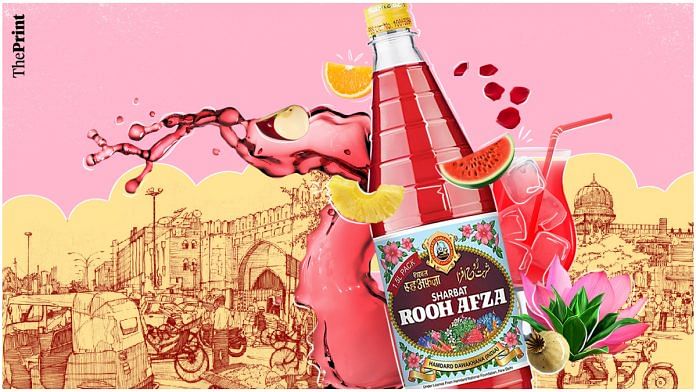Known for his flamboyant utterances, Oscar Wilde once said “Let me be surrounded by luxury! I can do without necessities.” This sentiment is true for many loved brands that may not really be essential in one’s daily life but exude a sense of comfort because they are charming.
Rooh Afza, a cooling squash with a luxuriant rose fragrance and attractive crimson shade, fits this description well. India has had a 117-year romance with this non-alcoholic syrup, which is diluted and drunk with milk or water and other concoctions.
Medicine to luxury
The story begins on an unusually hot summer day in 1907 in Delhi — the loo and dry heat, much like today, took a toll on people. Hakeem Hafeez Abdul Majeed, a unani or traditional medicine practitioner, combined various fruits, medicinal herbs, flowers, and condiments to create a medicinal beverage to hydrate and cool the body. The original concoction included fruits such as orange, watermelon, pineapple, and apple. Other ingredients included kewda, coriander, khus khus (poppy seeds), and flower extracts of rose and lotus. From the large cauldron containing the deep red syrup, Hakeem Majeed would serve his customers their portions, which they took in their own glass bottles and utensils.
Within a year, this concoction became so popular that Hakeem Majeed had to formalise his business. He named the drink ‘Rooh Afza’, meaning soul refresher. Choosing a simple glass bottle with five distinct rings around its tapering neck, the hakim hired a local printer from Old Delhi’s Hauz Qazi area to design an eye-catching red label for his brand. Rooh Afza was spelt in three languages – Hindi, English, and Urdu. And even today, nothing has changed.
Rooh Afza began to be produced on an industrial scale in Ghaziabad. Hakeem Majeed’s wife, Rabea Begum, used to assist her husband and supervised the whole production process. When the founder died in 1922, she and her two sons established the ‘Hamdard Trust’ and continued to manufacture Rooh Afza.
“Hamdard means someone who has empathy — a companion in pain. The trust was committed to using 85 per cent of its profits for charity. We continue to follow that motto,” says Hamid Ahmed, the great-grandson of Hakeem Majeed and the current CEO of Hamdard Laboratories.
Also read: Sita Ram Diwan Chand, Paharganj’s one-dish restaurant selling Lahori chole bhature since 1947
Chuski, falooda, kulfi
Over the years, the beverage gathered a greater fan following. From a medicinal concoction, Rooh Afza became a luxury non-alcoholic sherbet served as a premier drink at festivals and weddings to esteemed guests. Across various kiosks in Old Delhi, Rooh Afza was blended in cold milk and consumed as a pre-meal appetiser. Generous amounts of syrup were drizzled on crushed ice and given to children as chuski or ice lollies. Splayed over translucent falooda or thick translucent vermicelli, it was served with kulfi to create a special flavour of handmade ice cream. “I believe it is nostalgia, family associations, and childhood memories that carried our brand forward in homes across India,” says Hamid Ahmed.
The second big shake-up happened during Partition. Hakeem Majeed’s elder son, Hakim Abdul Hameed, stayed in India to run the original Hamdard Trust while his brother, Hakim Mohammad Said, migrated to Pakistan and started producing Rooh Afza in Karachi.
Hakim Abdul Hameed and the generations after him continued to follow the original trust deed, which has clear clauses on how income and profits are to be used. Since the founder’s family could only retain 15 per cent of the net profits. The rest of the revenue from the sale of Rooh Afza and other products made by Hamdard was accumulated over the years to be ploughed back into community service-related activities. “In 1964, the Hamdard trust, through Hamdard National Foundation (India) used its corpus to purchase 91 acres of land near Tughlaqabad Fort to set up science-based medical institutes with student training and patient care as their core activity. Education, healthcare, and livelihood are the focus. These institutes came together to form the Jamia Hamdard University in 1989. We now have over 9,000 students who are trained in traditional medicine systems, management, life sciences and healthcare,” says Hamid Ahmed.
Also read: Baggi, bandhgalas, baajas—Sohan Lal & Sons Ghori Wala pioneered the baraati band in Delhi
What makes Rooh Afza unique
Hamdard Laboratories manufactures dozens of traditional medicines today, and its new focus areas include food verticals with multiple offerings like spices, ready mixes of popular Indian dishes, and high-end products like saffron and organic honey. But Rooh Afza remains the biggest driver of Hamdard’s business, contributing to around 85 per cent of the revenue. In the year 2021, total revenue was Rs 565 crore, of which around Rs 500 crore came from Rooh Afza sales alone.
What gives Rooh Afza this unique advantage? The answer lies in the emotional associations it evokes. Almost everyone looks back at their childhood with rose-tinted glasses. Many remember how their mothers would coax them to drink milk by adding a spoonful of Rooh Afza to sweeten the taste. Many remember their grandparents or relatives who would ritually drizzle a spoonful of this syrup on their evening dessert. Women would smile as they remember how they would serve a tray of Rooh Afza drinks to guests in an arranged marriage setup.
Long Indian summer months, punishing loo, and throttling dust storms—all seem to become bearable with a glass of Rooh Afza. And therein lies the pull of this sticky brand.
This article is part of a series called BusinessHistories exploring iconic businesses in India that have endured tough times and changing markets. Read all articles here.
(Edited by Humra Laeeq)



